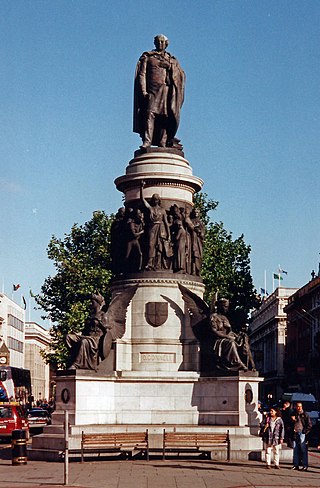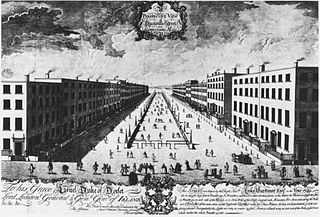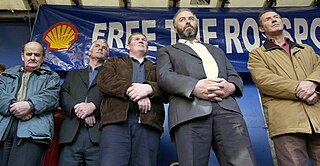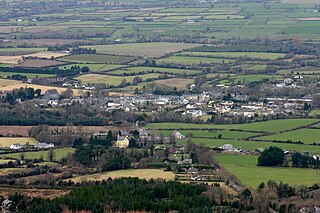
O'Connell Street is a street in the centre of Dublin, Ireland, running north from the River Liffey. It connects the O'Connell Bridge to the south with Parnell Street to the north and is roughly split into two sections bisected by Henry Street. The Luas tram system runs along the street.

Georgian Dublin is a phrase used in terms of the history of Dublin that has two interwoven meanings:
- to describe a historic period in the development of the city of Dublin, Ireland, from 1714 to the death in 1830 of King George IV. During this period, the reign of the four Georges, hence the word Georgian, covers a particular and unified style, derived from Palladian Architecture, which was used in erecting public and private buildings
- to describe the modern day surviving buildings in Dublin erected in that period and which share that architectural style

The Wide Streets Commission was established by an Act of Parliament in 1758, at the request of Dublin Corporation, as a body to govern standards on the layout of streets, bridges, buildings and other architectural considerations in Dublin. The commission was abolished by the Dublin Improvement Act of 1849, with the final meeting of the Commission taking place on 2 January 1851.

Timothy Joseph Murphy was an Irish Labour Party politician who served as Minister for Local Government from 1948 to 1949. He served as a Teachta Dála (TD) for the Cork West constituency from 1923 to 1949.
The Land Acts were a series of measures to deal with the question of tenancy contracts and peasant proprietorship of land in Ireland in the nineteenth and twentieth centuries. Five such acts were introduced by the government of the United Kingdom between 1870 and 1909. Further acts were introduced by the governments of the Irish Free State after 1922 and more acts were passed for Northern Ireland.

Castle Coole is a townland and a late-18th-century neo-classical mansion situated in Enniskillen, County Fermanagh, Northern Ireland. Set in a 1,200-acre (490 ha) wooded estate, it is one of three properties owned and managed by the National Trust in County Fermanagh, the others being Florence Court and the Crom Estate.
Ballygar is a village in County Galway, Ireland. It is 19 km from Roscommon town.

Frenchpark, historically known as Dungar, is a village in County Roscommon, Ireland on the N5 national primary road. It was the home of Douglas Hyde, the first President of Ireland. The nearby French Park Estate was until 1952 the ancestral seat of the French family, Barons de Freyne. The estate was sold to the Irish Land Commission in the 1950s and was dismantled by the mid 1970s. A historic smokehouse is one of the few remaining legacies of this period.

Ashford Castle is a medieval and Victorian castle that has been expanded over the centuries and turned into a five star luxury hotel near Cong on the Mayo-Galway border, on the Galway side of Lough Corrib in Ireland. It is a member of the Leading Hotels of the World organisation and was previously owned by the Guinness family.

The Rossport Five are Willie Corduff, brothers Philip and Vincent McGrath, Micheál Ó Seighin and James Brendan Philbin, from Kilcommon parish, Erris, County Mayo, Ireland. In 2005, they were jailed for civil contempt of court after refusing to obey a temporary court injunction forbidding them to interfere with work being undertaken by Shell on their land.

Frescati House was a Georgian house and estate situated in Blackrock, Dublin. It was built in 1739 for the family of John Hely Hutchinson, the Provost of Trinity College.

In the controlled demolition industry, building implosion is the strategic placing of explosive material and timing of its detonation so that a structure collapses on itself in a matter of seconds, minimizing the physical damage to its immediate surroundings. Despite its terminology, building implosion also includes the controlled demolition of other structures, such as bridges, smokestacks, towers, and tunnels.

Clogheen is a village in County Tipperary, Ireland. The census of 2016 recorded the population at 478 people.
Contraception was illegal in Ireland from 1935 until 1980, when it was legalised with strong restrictions, later loosened. The ban reflected Catholic teachings on sexual morality.
Michael Barrett was an Irish activist. He was a member of the Fenians.

Castlemaine is a small village in County Kerry, southwest Ireland. It lies on the N70 national secondary road between Killorglin and Tralee.

Agher is a crossroads and townland in County Meath, Ireland. It is located 3 km (1.9 mi) southwest of Summerhill.
John W. Moher was an Irish Fianna Fáil politician, auctioneer and farmer who was a member of Dáil Éireann representing the Cork East constituency. He was the son of William Moher and Ellen Lyons of Curraghmore, County Cork. He married Sheila O'Neil.

Transparency International's 2021 Corruption Perceptions Index scores Ireland at 74 on a scale from 0 to 100. When ranked by score, Ireland ranked 13th among the 180 countries in the Index, where the country ranked first is perceived to have the most honest public sector. For comparison, the best score was 88, and the worst score was 11.

Public housing in the United Kingdom, also known as council housing or social housing, provided the majority of rented accommodation until 2011 when the number of households in private rental housing surpassed the number in social housing. Dwellings built for public or social housing use are built by or for local authorities and known as council houses. Since the 1980s non-profit housing associations became more important and subsequently the term "social housing" became widely used, as technically council housing only refers to housing owned by a local authority, though the terms are largely used interchangeably.
















